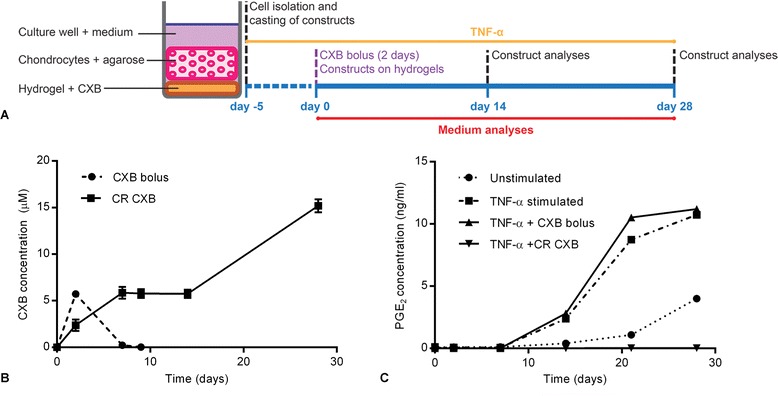Fig. 2.

In vitro controlled release of CXB results into sustained suppression of PGE2 levels in the presence of a proinflammatory stimulus. a Experimental setup to evaluate the controlled release of celecoxib (CXB) in vitro. During the first 5 days of culturing, three-dimensional chondrocyte constructs were stimulated with a proinflammatory cytokine TNF-α (10 ng/ml). At day 0 of the experiment, a 10 μM bolus injection of CXB was applied for 2 consecutive days or pNIPAAM MgFe-LDH hydrogels loaded with 1 mg/ml CXB (CR CXB). Media were refreshed every 2–3 days and collected on days 0, 2, 7, 9, 11, 14, 21, and 28. On days 14 and 28 the constructs were evaluated for cell viability. b Celecoxib (CXB) concentrations (μM) were measured in medium samples after administering the bolus injection of CXB or the pNIPAAM MgFe-LDH hydrogel loaded with 1 mg/ml CXB (CR CXB) c. PGE2 concentrations (ng/ml) measured in medium samples in the following conditions: unstimulated, stimulated with 10 ng/ml TNF-α (TNF-α stimulated), TNF-α stimulated in the presence of a 10 μM bolus injection of celecoxib (CXB bolus) for 2 consecutive days, or 1 mg/ml CXB-loaded pNIPAAM MgFe-LDH hydrogels (CR + CXB). Data are expressed as mean ± standard deviation. CR control, LDH layered double hydroxide, PGE 2, prostaglandin E2, pNIPAAM poly-N-isopropylacrylamide, TNF-α tumor necrosis factor alpha
